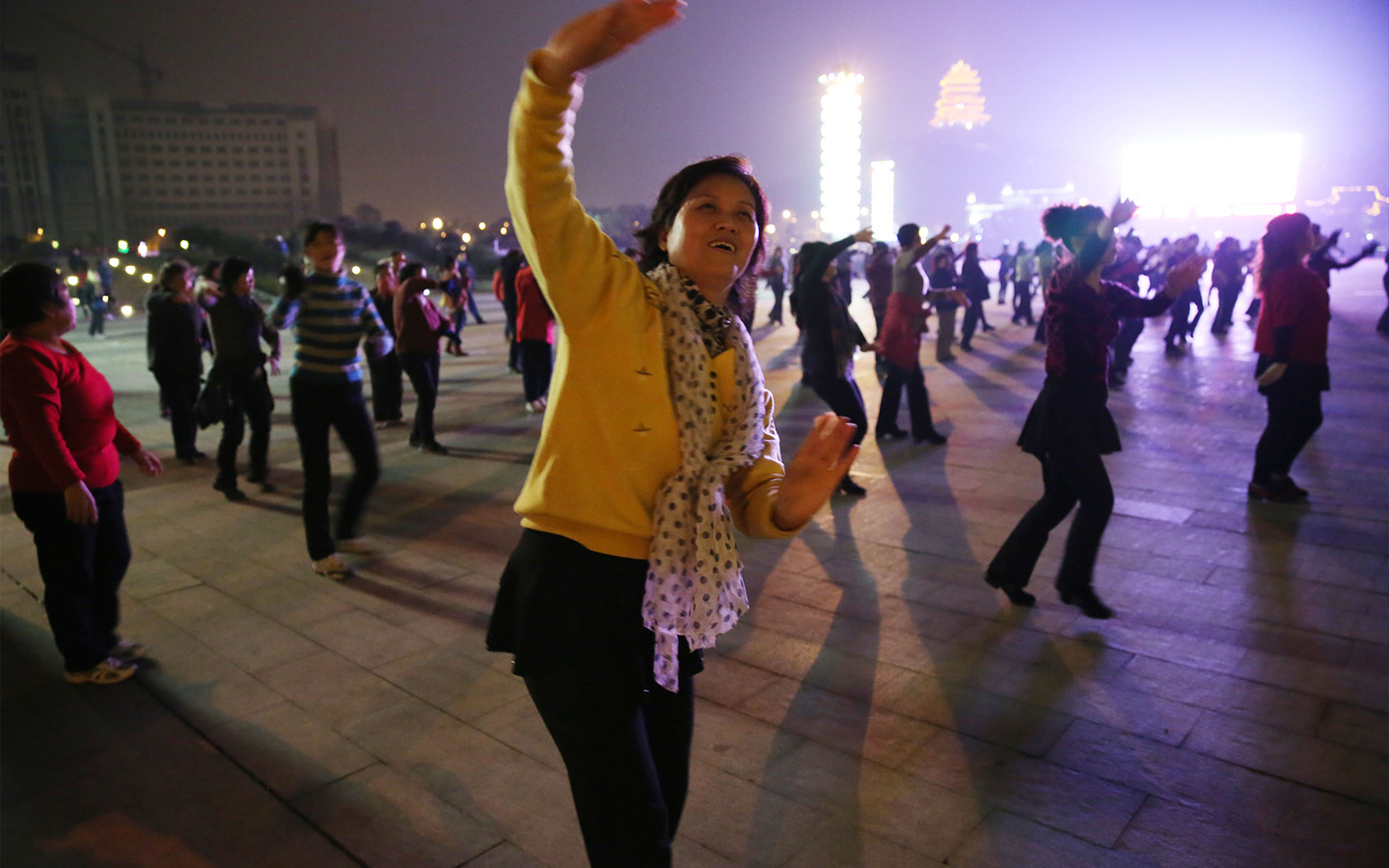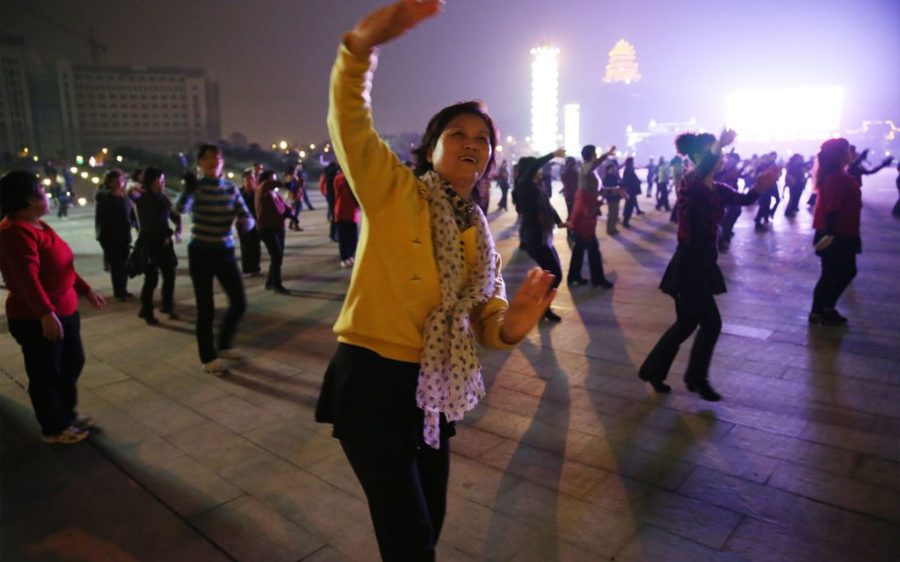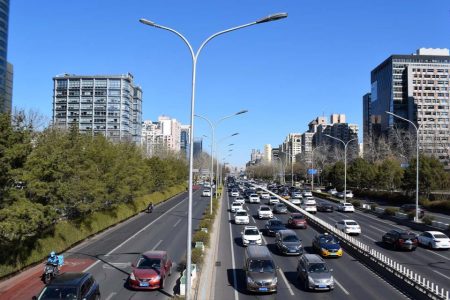On 7 November 2016, some 50,000 people dressed in matching red jump suits packed the stadiums and sport fields of 14 cities in China. Organised neatly into long rows, these individuals began simultaneously performing the same dance routine on cue, gyrating their arms and moving their hips to the beat of the music.
After a little over five minutes, the dancers ended their carefully orchestrated performance, content in the knowledge that they had just broken the Guinness World Record for the world’s largest square dance performance across multiple venues.
Square dancing or plaza dancing (guǎng chǎng wǔ, 廣場舞, as it is known in Chinese), is a common sight throughout mainland China’s urban centres. (It’s not to be confused with the American form of square dancing, where “square” does not refer to the civic spaces where the dance takes place but to the square formation of the dancers.)
[See more: What is the Beijing Bikini?]
Often performed in open squares and parks in the late afternoons and evenings, this dance form is especially popular with dà mā (大媽) – the Chinese term for middle-aged and elderly Chinese women. China’s Ministry of Culture and Tourism reported in 2023 that over 120 million people in the country were regularly engaged in this form of dancing, which can vary significantly in scale, with groups ranging from just several people to 100 or more dancers.
Keep reading to find out more about the history of square dancing, as well as other facets of this popular Chinese pastime.
How did square dancing emerge in China?
The origins of square dancing are multi-faceted, reflecting modern day Chinese cultural traditions, as well as the country’s historic development in recent decades.
In an interview with the South China Morning Post, Mi Li, an academic with the Central South University who spoke extensively with square dancers, noted that the practice can be seen as a holdover from the Cultural Revolution, which instilled ideas of collectivism and communal activities on a whole generation of Chinese women.
Many older women “collectively took part in massive political movements in squares when they were children and teenagers,” she said. “They can strongly feel the sense of presence and safety in squares with others.”
In some instances, dancing formed a part of these political events, as illustrated by the “loyalty dance” (zhōngzì wǔ, 忠字舞), which was performed in groups during the Cultural Revolution to express one’s devotion to Chairman Mao.
[See more: A brief history of the facekini]
The wave of layoffs that coincided with structural reforms to Chinese government-owned businesses in the 1990s has been cited as another reason for the popularity of square dancing. According to Teng Wei, the director of South China Normal University’s Centre for Contemporary Cultural Studies, a significant number of today’s older women were among the tens of millions who were sacked during this period.
“With a strong desire to pursue health and entertainment, but a lack of public facilities, they had plenty of time but little money,” Teng told the South China Morning Post, adding that “low-cost square dancing soon became the most fashionable form of exercise for Chinese dà mā.”
Interest in square dancing also grew in the lead up to the 2008 Beijing Olympics, as the central government put forward a “Nationwide Physical Fitness Program” aimed at encouraging Chinese citizens to be more active.
What are the benefits of square dancing?
The health benefits of square dancing are one of the main reasons why so many dà mā are engaging in the practice. As 71-year old square dancer Yan Fuzhi told Reuters, “it’s good for my health and it gets rid of bad habits…I used to sit watching TV, which is bad for my heart and causes high blood pressure. But I’m really happy when I dance, listening to the music, chatting and laughing. All my problems go away.”
Academic studies have shown that this form of communal dancing can indeed enhance the overall health of seniors. For instance, a review of 24 preexisting studies conducted by researchers from the Hong Kong Baptist University in 2022 found a positive correlation between square dancing and a boost in dancers’ mental, physical and cognitive abilities.
[See more: Explainer: What is the Asian Squat?]
Similarly, a 2024 Chinese study featured in the journal Frontiers in Public Health concluded that square dancing was associated with a better quality of life and well-being for middle-aged and elderly individuals. It noted that the dance’s communal nature may be more effective than individualised exercise such as yoga and tai chi “in promoting social interactions and positive emotional experiences.”
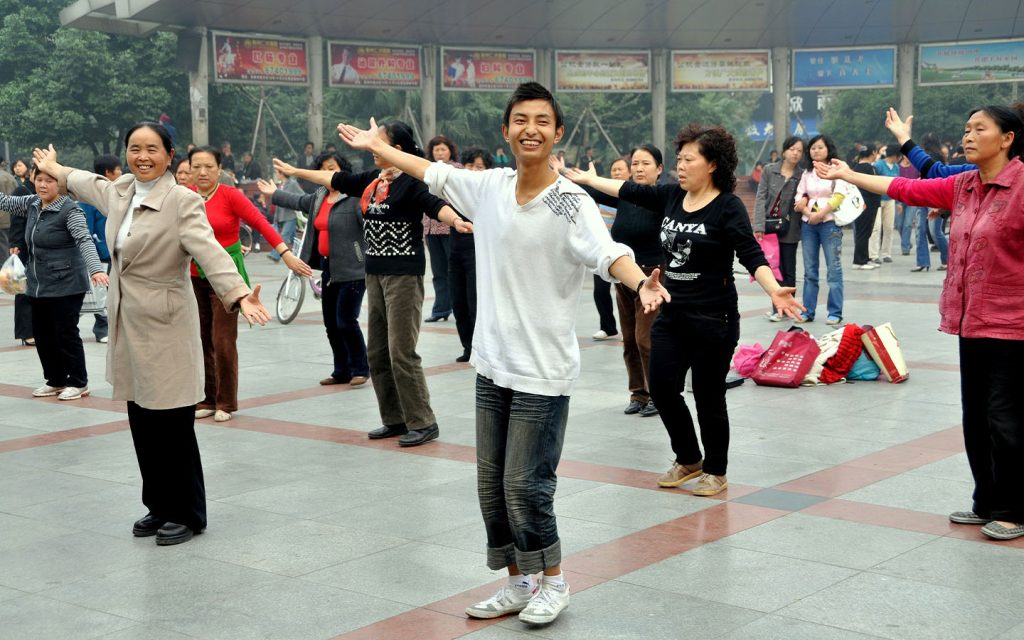
What do people think about square dancing?
Opinions about square dancing are split, with some viewing it as an admirable activity and others considering it to be a nuisance.
In an interview with China Daily, one US reader described it as “absolutely wonderful” and was amazed by the variety of dances that he witnessed, which included “Chinese dances, Latin dances, 1950s style sock hop, country line dancing, the fox trot and everything else.”
[See more: Why are day parties becoming popular in Macao and Hong Kong?]
In contrast, the noise pollution remains a sticking point for some, with one Chinese interviewee stating that he was against group dancing, as “you’re deprived of the right to enjoy some after-dinner quiet.”
Another interviewee who was identified as an expat in China was more nuanced in his view, noting that he had no issues with square dancing, although he added that the participants shouldn’t abuse good will by using loud speakers. “If people enjoy square dancing, it’s fine, but they should have more consideration for the people around them. Nobody likes to be bothered.”
What are some popular songs that are used in square dancing?
There is no set playlist when it comes to square dancing, although pop and patriotic songs tend to be a perennial favourite among many square dancing groups. Some songs that have garnered a strong following over the years include “Little Apple (小苹果)”, an upbeat and catchy Mandopop song that references square dancing in its music video.
Other popular tracks include Chinese pop duo Phoenix Legend’s (鳳凰傳奇) “Tao Ma Gan (套馬桿)” and “The Most Dazzling Folk Style (最炫名族風).”
[See more: Here’s how to rent a shared bike in China]
Outside of Chinese-language songs, KPop hits such as “Gangnam Style” and “New Face,” as well as Girls’ Generation’s “Gee” have also been used.
Is square dancing only for Chinese aunties?
No. Although Chinese dama make up the bulk of square dance lovers, it is not unusual to see some middle-aged or elderly Chinese men – colloquially known in Chinese as dà ye (大爺) – taking part in the dance.
Over the years, there have been various media reports of men joining in the ranks of female square dancers. As well, the 2018 Chinese documentary, Dance on the Square, follows the stories of three elderly square dancers, including two men – Mr Zhou, a 74-year old looking to return a portrait to his first love, and Mr Xiong, a 70-year old who relieves the stress of looking after his 105-year old father by dancing.
Some young Chinese are embracing square dancing as well. For instance, the South China Morning Post reported in 2023 that one 22-year old male TikTok influencer with the nickname Xiaobai had been uploading videos of himself performing square dancing, amassing some 714,000 fans.
[See more: Here’s how to claim your tourist tax refund in China]
On the appeal of square dancing, Xiaobai said that he enjoyed the excitement and the feeling of “coming home” whenever he returns to “that familiar square.”
Meanwhile, Xu Wensheng of the National First Media Sociology Professional Committee told the South China Morning Post that the adoption of square dancing by young people was an expression of their desire to improve their lives and to adopt the lifestyle of older adults.
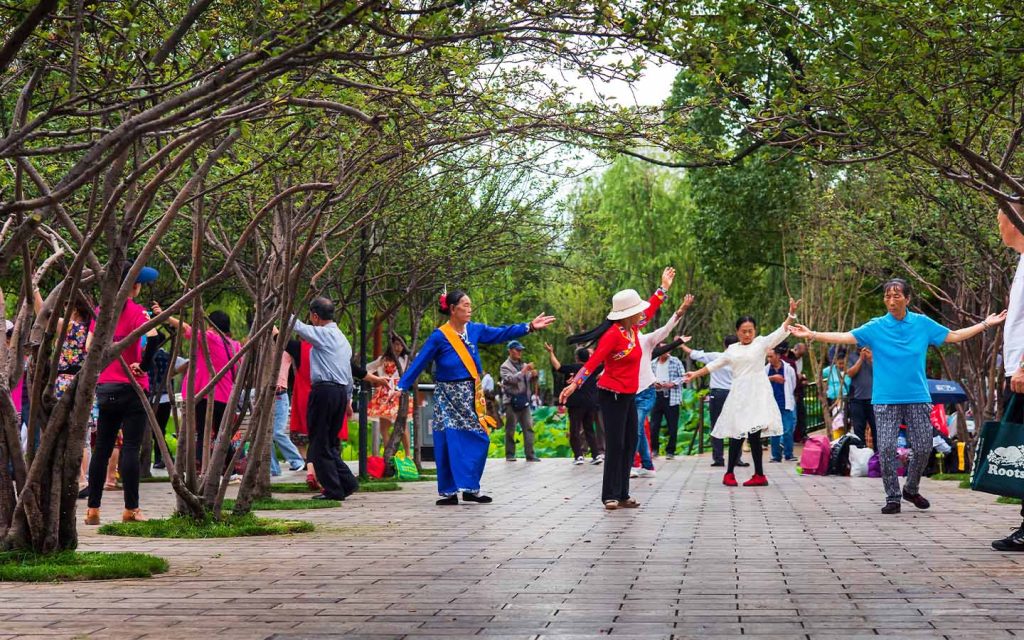
What attire should you wear when square dancing?
There are no hard and fast rules on what you should and shouldn’t wear when square dancing, although some of the more professional groups may wear uniforms and costumes, complete with handfans and dancing scarves.
Life Times, a Chinese state newspaper covering health topics, recommends wearing a pair of comfortable, soft sole shoes that are slip resistant. As dancers will be constantly moving their legs around, the outlet also advises against wearing flip-flops, hard sole shoes and skin-tight pants.
[See more: Five great places for hiking in the Greater Bay Area]
Some square dancing groups have also taken to wearing headphones in a practice that has been dubbed “muted square dancing.” Hoping to avoid disrupting the people around them, these groups have replaced their loudspeakers with headphones connected to a central system that allow each member to enjoy the same music.
Where can I find square dancers?
As mentioned, square dancers can be found in open spaces such as major squares and parks, with many groups preferring to dance in the late afternoons and evenings. For a list of some of the major locations in China where square dancers can be found, click here.
Square dancing is much rarer in Macao and Hong Kong due to the lack of space and a somewhat different culture. If you are on the hunt for square dancers in Macao, you’ll probably have the most luck finding them in Iao Hon Market Park and the leisure area in Praceta de Venceslau de Morais.
[See more: Rebel Z: From Macao to the World of Dance in Los Angeles]
In a show of its extensive reach, square dancing has also found its way overseas in countries as far reaching as the US and Australia.
Are there any square dancing apps that I can use to boost my routine?
In a sign that square dancing is changing with the times, there are now even mobile apps specially designed for square dancers. The most popular one is arguably Tangdou, which allows square dancers to connect with one another, watch square dancing videos and post their own content. Some estimates put the user base at around 200 million. To download the app, click here.
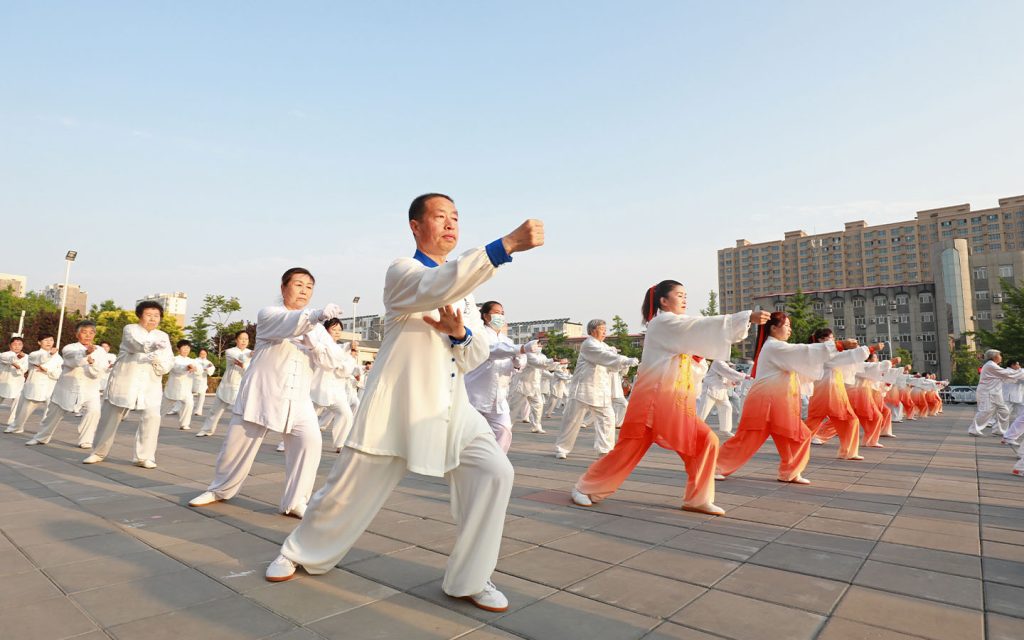
What other Chinese-style dances are popular in the mainland?
Yangge (秧歌舞) or niu yangge (扭秧歌), a folk dance that originated in the villages of northern China, is also quite popular, especially among older Chinese women. Much like square dancing, it is performed in groups, although instead of lively pop songs, it features energetic music with drums, gongs, cymbals and other traditional Chinese instruments.
Although yangge can vary in style depending on the region, the dance in all its forms can be readily identified by its upbeat and rhythmic movements and eye-catching costumes. In some performances, props such as scarves and handkerchiefs are used, as illustrated by this 2025 Spring Festival gala “Yang Bot” performance, which was directed by renowned Chinese filmmaker Zhang Yimou.
[See more: On pointe: Where can you learn ballet in Macao?]
Another Chinese dance that has garnered attention in recent years is ke mu san (科目三), a viral online dance that requires performers to sway their legs back and form while moving their arms in an exaggerated manner to the song “Yi Xiao Jiang Hu (一笑江湖).”
Most agree that ke mu san comes from Guangxi province, although there is less consensus on its origin story. Regardless, the dance became very popular among young people, especially after videos circulated of Haidilao staff performing the routine to entertain guests in November 2023.
